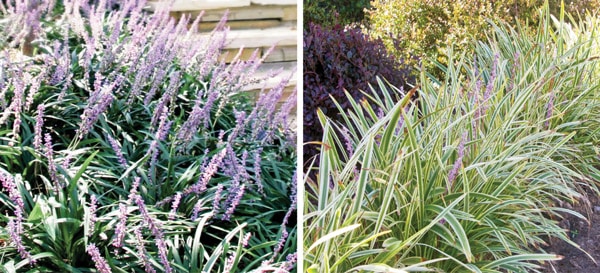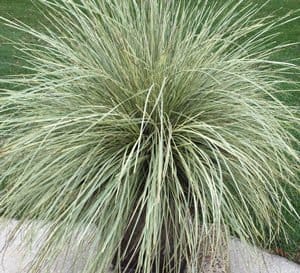In the Landscape
Ornamental grasses are hardy, drought tolerant and low-maintenance plants that can be used as accents in the landscape or on a patio; can add color, texture and sound to the garden; work well in natural or formal garden settings; and will add interest and structure even in the winter.
To find just the right ornamental grass for your needs, begin by matching the plant’s needs to the lighting, soil and moisture options of the space where they will be planted, then think about what size plant works best in that spot.
Designing
Ornamental grasses range from low-growing groundcovers to towering showpiece specimens that offer a wide range of design opportunities.

First, try the Carex EverColor® Series, such as the Southern Living® Plant Collection ‘Everest’, to add easy elegance and dramatic touch to any landscape setting. ‘Everest’ grows 18″ high x 18″ wide and is a superb groundcover and container plant with distinctive white striped foliage. It is easy to grow, low maintenance, and forms a neat, easily controlled, mound. Everest is a great cold-hardy accent plant for year-round plantings.
‘Everest’ thrives in zones 5 – 9 and serves as a great mass planter, as well as brightening up containers and groundcover year-round.
Use these plants as focal points in a landscape, in mass plantings, as screens, by ponds and other water features and even in pots.
Groundcovers

Liriopes, such the Southern Living Plant Collection’s Marc Anthony™, are great for borders, on slopes, and in containers. Marc Anthony is a one-of-a-kind liriope with variegated tri-colored foliage that is golden yellow and green in the spring, becoming white and green as it matures. Producing spikes of flowers in the summer with hints of pink and lavender in the stalks and blooms.
Both miscanthus and liriope can be used alone but also work well with other plants, such as interspersed with other grasses, wildflowers and bulbs and intermingled with shrubs and other plants in garden beds.
Fall is actually a great time to plant ornamental grasses because they have time to become established before the spring growing season begins. Just get them in the ground a month or more before the first hard freeze and water thoroughly immediately after planting, then mulch them to help protect their roots from low winter temperatures.
Pruning
Leave the foliage on them through the fall and winter, cutting them back only in late winter or early spring to spur new growth. The foliage in the winter helps protect the plants from freezes and frosts and insulates the roots.
Don’t have time to get them in the ground before freezing weather sets in? Then use them as container plants that can be transplanted in the yard in late winter or early spring. While they are adding indoor beauty to your home, spend some time this fall preparing the soil where they will eventually be placed in the landscape by mixing in organic matter that will break down in the winter and give them a healthy start in the spring.
Once they’re in the ground, sit back and relax. They will soon be turning your yard into a grass act.









